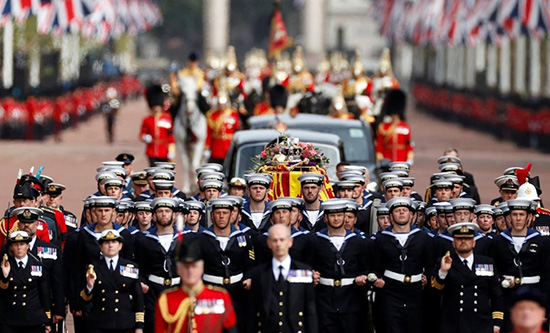
A magnificent display of British exceptionalism was on show at the state funeral of Queen Elizabeth II. The dressing-up box of militarism with its gorgeous uniforms represented every battle since Waterloo and throughout the British Empire. Here too were feudal symbols of authority, swords and jewels from the 12th century, resurrected and repurposed by the Victorians. In descending order from the Monarch as Head of the Protestant Church of England were archbishops, bishops, other clergy, parliamentary ministers, the military, the police force, judges, magistrates and public servants. All had been appointed to their posts with the oath ‘I do swear that I will be faithful and bear true allegiance to Her Majesty Queen Elizabeth II, her heirs and successors, according to law. So help me God’. This same oath of allegiance has been pledged by thousands born overseas at British citizenship ceremonies.
A uniting of classes
In 1640 the rising merchant class of England demanded increased representation in parliament and limits on the autocratic power of the monarch to impose taxes. This led to the English Civil War and the execution in 1649 of Charles I, accused of tyranny and treason, after a trial in Westminster Hall. With the Restoration of the monarchy in 1660 with Charles II on the throne the gradual growth of shared power between the aristocracy and the new class of capitalists evolved into a national state. As the industrial revolution developed, the landed aristocracy became businessmen and the capitalists bought land.* The constitutional monarchy represents a reconciliation of the interests of these factions of the ruling class, and continues to play a vital role in sustaining the unity of the state against the working class.
A real estate shell company
In theory the monarch continues to legally own all the lands of Britain, Canada, Australia, New Zealand, 32 other members (around two-thirds) of the Commonwealth, and the British Antarctic Territory. In practice, the British Crown owns 263,000 acres across the UK and more than half the UK’s entire seashore, giving it hugely valuable auction rights for offshore commercial activity, such as wind farms.
The secretive and opaque Crown Estate administers royal properties dealing with £15.2bn worth of assets, the profits of which go to the UK Treasury, with 15% going to the monarch. The institutionalisation of royal property rights is tolerated by the rest of the ruling class who regard it as the guarantor for the legal protection of all forms of private ownership and inheritance rights. Its servile media has meekly acceded to a demand by the royal family that it should have a veto over what footage from the queen’s funeral can be broadcast in the future.
Continuity and calm?
The sycophantic bourgeois media has babbled continuously about the nation’s shared ‘sense of loss’ and the hope that the reign of Charles III will preserve the unity of the people. Do they fear the propertyless and working class resistance? We hope so.
Susan Davidson
*For more on the development of land ownership in Britain see Whose land is it anyway? Housing, capitalism and the working class FRFI pamphlet Larkin Publications 2018
FIGHT RACISM! FIGHT IMPERIALISM! 290 October/November 2022




